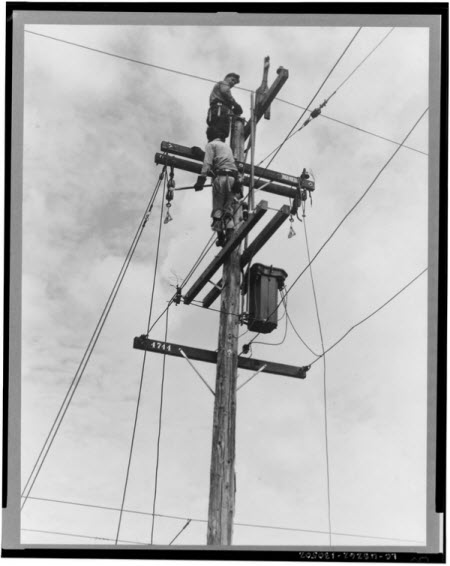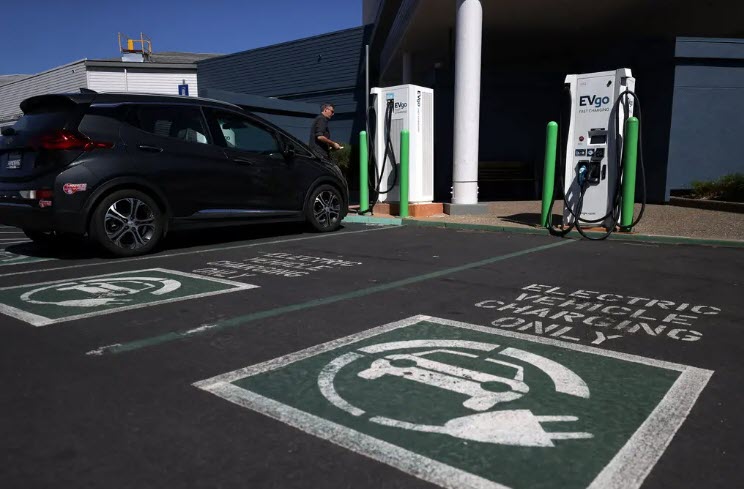Biden Wants an All-Electric America. The Grid Has a Problem
Mar 31 2023President Biden expects to reduce U.S. emissions 50% below 2005 levels by 2030, and to arrive at net zero emissions from all the nation's power plants by 2035. "The gap between wishful thinking and reality is vast", says naysaying scientist Vaclav Smil.
"People don’t appreciate the magnitude of the task and are setting up artificial deadlines which are unrealistic. People toss out these deadlines without any reflection on the scale and the complexity of the problem."
Writing in The New Yorker, environmental journalist Elizabeth Kolbert underscores Smil's bracing caveat, telling us that the U.S. electrical 
grid…
”…comprises more than eleven thousand generating plants, more than six hundred thousand miles of high-voltage transmission lines, and some six million miles of distribution lines."
Our grid has been called “the largest machine ever built by man.” The U.S. electrical system is becoming less reliable. Fossil-fuel power plants are going out of service faster than renewable sources are being installed, which could lead to increasing brownouts and blackouts. In 2000, there were fewer than 50 major outages. In 2020, the number approached 200.
Much of its transmission infrastructure is in need of upgrade, having been built just after World War II and even before, and weighing on that, it is now to undergo a total transformation to accommodate Biden's flank speed conversion to wind and solar.
a far piecePower plants have typically been built close to existing transmission lines because such connections are costly to build. But with wind and solar, a power project doesn't get to pick a convenient location. That means thousands of miles of new transmission lines are needed criss-crossing the country to bring power generated where the wind blows the most and the sun shines the brightest to the population centers where the power is needed. In his infrastructure bill, Biden appropriated $73 billion for thousands of miles of new power lines. Cost estimates range much higher. A 2021 report from the American Society of Civil Engineers says that, with 70% of lines "well into the second half of their expected 50-year lifespans", more like $200 billion is needed for existing lines. The 2035 goal of decarbonizing demands over a million miles of new transmission lines, in one estimate. The cost of stringing all these lines will, in another estimate, come to more than $2 trillion.
juice locavores
Power utilities, the renewable energy industry, and environmental groups split on which is the better option, transmission at a distance or decentralization of power sources. Keeping it local — rooftop solar and microgrids 
for towns and neighborhoods to generate their own electricity — would at least reduce the need for transmission lines and would be on stream far more quickly. Energy Secretary Jennifer Granholm said the administration supports that but decentralized approaches would not be sufficient to achieve the president’s 2035 goal.
So the administration barged ahead with the Inflation Reduction Act with climate provisions that provide for less than $30 billion of what we understand to be largely subsidies for "home energy efficiency upgrades" and "home energy supply improvements". Bernadette Del Chiaro, director of an organization that lobbies for the rooftop solar industry, said to The New York Times,
"Clearly, the utilities are stuck in the 20th century; they want to build the transcontinental railroad of the electric grid.”
Nimby
Transmission towers and power lines are not welcome by those who live along their route. People don't want the disruption and the defacement of their woods and farmlands for delivery of power that will benefit some
other state. Announce a project and environmental activists are likely to raise a ruckus. Kentucky and 
In this famous 1938 photo by Dorothea Lange, workers install power lines
in the San Joaquin Valley of California under a rural electrification program
launched by President Franklin D. Roosevelt. (Library of Congress)
Virginia have seen plans for 3,000 acres of solar panels delayed. A 720-mile link from Oklahoma wind farms to Tennessee was cancelled when Arkansas refused transit. A line from Kansas to Indiana has been held up for a decade owing to Missouri's objections. A single Colorado family has stalled for years a transmission project from Wyoming to supply cities on the West Coast.
When passage of a transmission line that was to bring hydropower from Quebec to the Boston area was thwarted by New Hampshire, lying in its path, it was remapped to pass through Maine, whereupon voters struck down that maneuver in a referendum even while work was already under way. Much of the referendum's backing was provided by NextEra, a nuclear plant operator in Maine that saw hydro as competition.
The Biden administration recognizes such objections, say officials, and hopes stringing power lines along highways, railroad tracks, and other existing rights of way could avoid conflicts.
what grid?
"How will you decarbonize and run the country by wind and solar without a national grid? And what will it take to build a national grid in a NIMBY society like the U.S.?"
That's Professor Smil again. The 80-year-old Czech-Canadian now retired after a career at the University of Manitoba is a highly-regarded realist who has authored 36 books, heavy with data and brutal fact, the latest being last year's "How the World Really Works". Bill Gates says he has read all 36. "I wait for new Smil books the way some people wait for the next Star Wars movie", Gates wrote in 2017. "He's a slayer of bulls**t," says David Keith, an energy and climate scientist at Harvard.
Smil says "without a national grid" because the country doesn’t have a national grid. It is instead, as a Reuters report put it, “a Byzantine web of local, state and regional regulators who have strong political incentives to hold down spending.” Texas didn't want federal oversight so it isn't even connected to the rest of the country, which was why it went cold and dark for four days and nights in February 2021 when freezing weather shut down power plants and wind turbines. Hundreds died.
hooking upThere is no shortage of renewable projects, but for lack of a true grid — instead “a Byzantine web of local, state and regional regulators who have strong political incentives to hold down spending” as a Reuters report put it — the hang-up is in hooking them up.
Say you've built a power source and perhaps even a transmission line to take its output to market. Just plug it into what we call the grid? Nowhere near that simple. Access is controlled by each state's utility commission which is often in the grip of local utility companies that may veto your application. More likely, a grid that didn't anticipate the onrush of renewable power often lacks the capacity for your new offering.
There were almost 3,500 new requests for hookup in 2021 compared to 1,000 in 2015, The Wall Street Journal reported last summer, citing research by the Lawrence Berkeley National Laboratory. As example, the Journal wrote that in 2021 renewable-energy developer Recurrent Energy filed more than 20 grid-connection requests in California, a state that needs more energy, yet is experiencing years of waiting. Requests to determine whether an area's lines can handle the load take an average of three years. A local utility's aging transformers and dated electrical lines may not be up to the job.
On top of that, the Biden administration is pressing for us all to switch to electric autos with our own garage charging stations; to get rid of gas ranges and water heaters; to heat and cool our houses with heat pumps; and to install solar panels that can feed electricity back to that utility that may not be able to handle it. Rewiring America, a nonprofit that advocates electrifying everything, calculated that if the 330,000 households in San Jose, California, stopped using gasoline and natural gas and made that switch, the city would need three times as much electricity as now. Extrapolate that to the entire country and ask how that is going to work out.
Fill 'er up!Autos alone, if fully converted to EV passenger vehicles, would require a 25% boost in electricity production. Renewables would have to supply it all, else more fossil fuel power plants would need to be built and what would be accomplished by converting to EVs?
Part of the president's goal for 2030 is 500,000 public charging stations in parking lots, schools, and parks, according to $2.5 billion in funding to states, local governments and tribes over the next five years.

Filling up at a gas station is quick and for the average auto will buy you close to 400 miles. But filling up (80% recommended as the last 20% takes forever) takes 20 to 30 minutes at a Level 3 fast-charger to yield something under 200 miles for a modest-size vehicle. That says the time-per-mile that we'll spend at a charging station is over 25 times what we spend at a gas pump. One easily imagines the pile-up of autos waiting at the public stations and an angry public quickly fed up with the whole idea.
So we clearly will need to clear the junk out of the garage and spend about $2,000 for a Level 2 charger for re-charging overnight (Level 3 is too expensive). The strain on the grid when everyone comes home from work and plugs in will be overwhelming. There seems to be no calculation by the Biden administration of how to be ready with the power at the other end of the hose that the conversion to electric vehicles — cars, bus fleets, government, the all-EV postal service — will demand.
wistful thinkingThe media doesn't dive very deep into the plausibility of Biden's program. They'll quote experts who say the enormous transformation of the grid is technically possible by the deadline years, but don't deal with the obstacles we've just explored. Articles conclude with sentences like,
"Analysts generally agree that it is entirely feasible to power many millions of new cars with electricity, but it will take careful planning"
…with no trepidation that only a dozen years remain until the 2035 deadline. Or,
"We know for a fact that such a program is possible, however. We know so for the simple reason that America has tackled grand projects on this scale before."
Cue stories of the America of yesteryear: the Hoover Dam, rural electrocution, World War II production. That was then, not now. Today's America takes an eternity to get anything done.
Please subscribe if you haven't, or post a comment below about this article, or
click here to go to our front page.


An excellent, well-crafted summary of the technological realities that could undermine Biden’s ambitious agenda, Much the same air of unreality infects his recent pledges on electric cars and trucks. We’ll need not only a zillion charging stations (backed by a thoroughly updated grid) but also a big leap forward by the engineers in Detroit, Japan and Europe, not to mention access we do not now have to the minerals necessary to build powerful batteries. Still, Biden deserves credit for placing the issue front and center and for at least charting (and providing serious $$ for) an overdue industrial strategy. What’s sad is thinking about all the years we’ve wasted since Jim Hansen, decades ago, warned us about warming and its consequences.